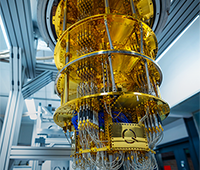 Started in 1993, The TOP500 project was developed to provide a reliable basis for tracking and detecting trends in high-performance computing. Twice a year, a list of the sites operating the 500 most powerful computer systems is assembled and released. The best performance on the Linpack benchmark is used as performance measure for ranking the computer systems. The list contains a variety of information, including the system specifications and its major application areas.
Started in 1993, The TOP500 project was developed to provide a reliable basis for tracking and detecting trends in high-performance computing. Twice a year, a list of the sites operating the 500 most powerful computer systems is assembled and released. The best performance on the Linpack benchmark is used as performance measure for ranking the computer systems. The list contains a variety of information, including the system specifications and its major application areas.
The TOP500 list is compiled by Erich Strohmaier and Horst Simon of Lawrence Berkeley National Laboratory; Jack Dongarra of the University of Tennessee, Knoxville; and Martin Meuer of the ISC Group, Germany.
The main objective of the project is to provide a ranked list of general-purpose systems that are in common use for high-end applications and, as such, the authors of the TOP500 reserve the right to independently verify submitted LINPACK results and to exclude systems from the list which are not valid or not general-purpose in nature. They explain that, by general-purpose system, they mean that the computer system must be able to be used to solve a range of scientific problems. It is important to note that any system designed specifically to solve the LINPACK benchmark problem or have as its major purpose the goal of a high TOP500 ranking will be disqualified. The systems in the TOP500 list are expected to be persistent and available for use for an extended period of time.
The deadline for the submission of new sites for the November release of the 46th TOP500 List is October 25, 2015, at 23:59 PST. All systems reported must be installed by November 1, 2015. The last date for submitting Linpack updates is also November 1, for systems submitted by October 25).
Submission guidelines
The submission site is open at http://top500.org/submit. (Note that this new interface requires users to create a new login and password.) Each submission should contain the following information:
- Manufacturer: Manufacturer or vendor
- Computer system: Type indicated by manufacturer or vendor
- Installation site: Customer — Full name of company or institution
- Location: Location and country
- Year: Year of installation/last major update
- Field of application: Type of customer (university, government, industry, …) as well as typical application (geophysics, automotive, chemical, benchmarking, …)
- Processors: Number of processors (as well as type if necessary)
- Memory: Main memory configuration of the system
- Linpack performance: Performance numbers for the Linpack benchmark are collected and updated by Jack Dongarra ([email protected]). Please report any Linpack performance numbers directly to him.
- Method of solution: In an attempt to obtain uniformity across all computers in performance reporting, the algorithm used in solving the system of equations in the benchmark procedure must confirm to LU factorization with partial pivoting. In particular, the operation count for the algorithm must be 2/3 n^3 + O(n^2) double point floating point operations. This excludes the use of a fast matrix multiply algorithm like “Strassen’s Method” or algorithms which compute a solution in a precision lower than full precision (64 bit floating point arithmetic) and refine the solution using an iterative approach. This is done to provide a comparable set of performance numbers across all computers. You can obtain an implementation of the appropriate software at: http://www.netlib.org/benchmark/hpl/
- Verification: In addition to cross checking different sources of information, the list’s authors select randomly a statistical representative sample of the first 500 systems of their database. For these systems, they will ask the supplier of the information to establish direct contact between the installation site and the authors to verify the given information. This provides basic information about the quality of the list in total.
Restrictions
As the TOP500 is intended to provide a basis for statistics on the market of high performance computers, the number of systems installed at vendor sites is limited. This is done for each vendor separately by limiting the accumulated performance of systems at vendor sites to a maximum of five percent of the total accumulated installed performance of this vendor. Rounding is done in favor of the vendor in question.
The List’s maintainers report that they are interested in new entries, as well as entries that are no longer valid. Please contact them if you have questions by sending mail to info at top500.org.



